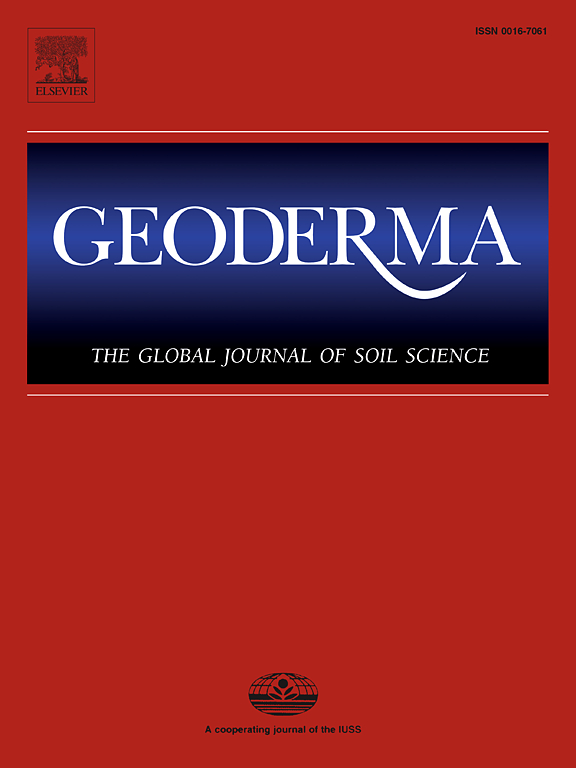土壤水、盐和微塑料在迁移过程中的相互作用:性能和机制
IF 5.6
1区 农林科学
Q1 SOIL SCIENCE
引用次数: 0
摘要
农田盐渍化和微塑料污染是威胁土壤生态系统的重要环境问题。然而,在MPs污染的盐碱地迁移过程中,土壤水、盐和MPs之间的相互作用仍未被探索。为了解决这个问题,我们使用四种不同盐度水平和聚乙烯MPs浓度的壤土进行了入渗试验。实验结果表明,MPs和盐类均能抑制水分入渗,且MPs的抑制作用随土壤盐分的增加而减弱。入渗后,MPs增加了土壤浅层(0 ~ 15 cm)的含水量,降低了土壤深层(15 ~ 30 cm)的含水量。含mp土壤深层总盐含量高于不含mp土壤。值得注意的是,MPs阻碍了Na+和SO42-的浸出,与SO42-相比,Na+的浸出阻碍更大。此外,MPs在非盐碱地更容易迁移,且高盐度对MPs迁移的抑制作用强于低盐度。机理分析表明,MPs通过其拒水特性、改变土壤孔隙大小分布和破坏土壤结构来影响水分运动。此外,盐类通过降低土壤水分的流动性和堵塞土壤大孔隙来影响水分的运动。此外,MPs表面带负电荷,可以通过静电力吸附土壤中的Na+,进一步影响盐的迁移。此外,盐离子的存在通过降低MPs粒子的静电斥力和增加MPs粒子的平均水动力直径来影响MPs的迁移能力。这些发现为为富含MPs和盐类的农田开发健康的土壤-作物系统提供了有价值的见解。本文章由计算机程序翻译,如有差异,请以英文原文为准。

Soil water, salt, and microplastics interact during migration: Performance and mechanism
Farmland salinization and microplastics (MPs) pollution are important environmental issues that threaten soil ecosystems. However, the interactions among soil water, salt, and MPs during migration in MPs-contaminated saline soils remain unexplored. To address this, we conducted an infiltration test using loam soils with four different salinity levels and polyethylene MPs concentrations. Experimental results showed that both MPs and salts inhibited water infiltration and that the inhibitory effect of MPs weakened with increasing soil salinity. After infiltration, MPs increased the water content in the shallow soil layer (0–15 cm) and decreased that in the deep layer (15–30 cm). Furthermore, total salt content of MPs-containing soils was higher than that of MP-free soils in the deep layer. Notably, MPs hindered the leaching of Na+ and SO42-, and a larger obstruction was observed for Na+ compared to SO42- leaching. In addition, MPs migrated more easily in non-saline soils, and higher salinity had a stronger inhibitory effect on MPs migration than lower salinity. Mechanism analysis indicated that MPs influence water movement through their water-repellent properties, changing the soil pore size distribution, and degradation of soil structure. Moreover, salts affect water movement by reducing the mobility of soil water and blocking soil macropores. Additionally, the surface of MPs is negatively charged and can adsorb Na+ in soil through electrostatic forces, further influencing salt migration. Furthermore, the presence of salt ions affects the migration ability of MPs by reducing their electrostatic repulsion and increasing the mean hydrodynamic diameter of MPs particles. These findings provide valuable insights for developing healthy soil–crop systems for croplands rich in MPs and salts.
求助全文
通过发布文献求助,成功后即可免费获取论文全文。
去求助
来源期刊

Geoderma
农林科学-土壤科学
CiteScore
11.80
自引率
6.60%
发文量
597
审稿时长
58 days
期刊介绍:
Geoderma - the global journal of soil science - welcomes authors, readers and soil research from all parts of the world, encourages worldwide soil studies, and embraces all aspects of soil science and its associated pedagogy. The journal particularly welcomes interdisciplinary work focusing on dynamic soil processes and functions across space and time.
 求助内容:
求助内容: 应助结果提醒方式:
应助结果提醒方式:


